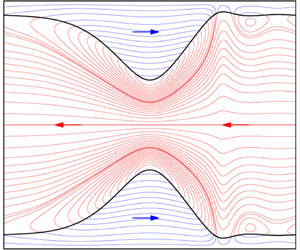Article contents
Falling liquid films in narrow tubes: occlusion scenarios
Published online by Cambridge University Press: 05 May 2020
Abstract

We study a gravity-driven wavy liquid film falling down the inner surface of a narrow cylindrical tube in the presence of an active core gas flow. We employ the model of Dietze and Ruyer-Quil (J. Fluid Mech., vol. 762, 2015, pp. 68–109) to investigate the role of surface waves in the occlusion of the tube. We consider four real working liquids and reproduce several experiments from the literature, focusing on conditions where the Bond number is greater or equal to unity. We prove that occlusion is triggered by spatially growing surface waves beyond the limit of saturated travelling-wave solutions, and delimit three possible regimes for a naturally evolving wavy film: (i) certain occlusion, when the liquid Reynolds number is greater than the limit of the spatially most amplified travelling waves. Occlusion is caused by surface waves emerging from linear wave selection (scenario I); (ii) conditional occlusion, when the most amplified waves possess travelling states but longer waves do not. Occlusion is triggered by secondary instability, generating long waves through nonlinear coarsening dynamics (scenario II); and (iii) impossible occlusion, when travelling waves always exist, no matter how great their wavelength. We show that certain occlusion is delayed by gravity and precipitated by a counter-current gas flow, axial viscous diffusion (high-viscosity liquids) and inertia (low-viscosity liquids). The latter two effects are also found to determine whether the occlusion mechanism is dictated by loss of travelling-wave solutions or absolute instability. Finally, we show that occlusion can be prevented through coherent inlet forcing. As a side benefit, we introduce an augmented version of our model based on a localized additional force term that allows representing stable travelling liquid pseudo-plugs.
- Type
- JFM Papers
- Information
- Copyright
- © The Author(s), 2020. Published by Cambridge University Press
Footnotes
Present address: Institut de Mécanique des Fluides de Toulouse (IMFT) - Univ. de Toulouse, CNRS-INPT-UPS, Toulouse, France
References
Dietz et al. supplementary movie 1
Spatiotemporal computation from panel 3c, corresponding to experiment in panel 3c of Camassa et al. (J. Fluid Mech., vol. 745, 2014, pp. 682-715). Case 1, Re=4.5E-4. Occlusion mechanism: surface waves grow spatially until their height attains the tube axis, whereupon individual gas bubbles are pinched off.
Dietz et al. supplementary movie 2
Spatiotemporal computation from panel 15c, corresponding to experimental run 20 in Dao and Balakotaiah (AIChE J., vol. 7, 2000, pp. 1300). Regime of certain occlusion: case 2, Re=0.0497. Scenario I: Occlusion is caused by spatially most amplified waves emerging from linear wave selection.
Dietz et al. supplementary movie 3
Spatiotemporal computation from panel 15d, corresponding to experimental run 13 in Dao and Balakotaiah (AIChE J., vol. 7, 2000, pp. 1300). Regime of conditional occlusion: case 3, Re=0.258. Scenario II: Occlusion is caused by wave coalescence due to secondary instability of the regular wave train emerging from linear wave selection.
- 12
- Cited by


